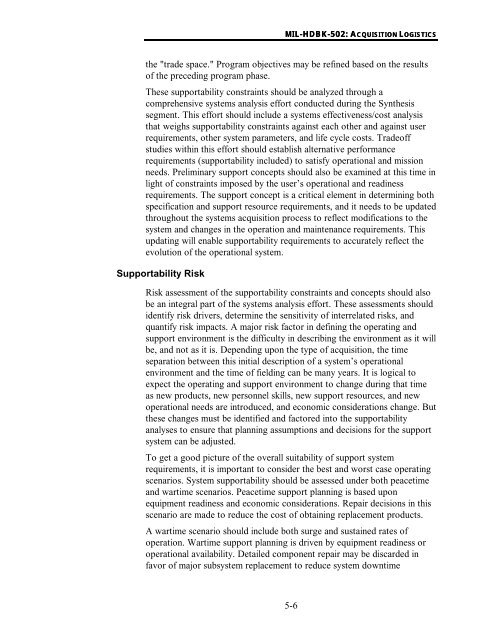MIL-HDBK-502 - Barringer and Associates, Inc.
MIL-HDBK-502 - Barringer and Associates, Inc.
MIL-HDBK-502 - Barringer and Associates, Inc.
Create successful ePaper yourself
Turn your PDF publications into a flip-book with our unique Google optimized e-Paper software.
<strong>MIL</strong>-<strong>HDBK</strong>-<strong>502</strong>: ACQUISITIONALOGISTICSthe "trade space." Program objectives may be refined based on the resultsof the preceding program phase.These supportability constraints should be analyzed through acomprehensive systems analysis effort conducted during the Synthesissegment. This effort should include a systems effectiveness/cost analysisthat weighs supportability constraints against each other <strong>and</strong> against userrequirements, other system parameters, <strong>and</strong> life cycle costs. Tradeoffstudies within this effort should establish alternative performancerequirements (supportability included) to satisfy operational <strong>and</strong> missionneeds. Preliminary support concepts should also be examined at this time inlight of constraints imposed by the user’s operational <strong>and</strong> readinessrequirements. The support concept is a critical element in determining bothspecification <strong>and</strong> support resource requirements, <strong>and</strong> it needs to be updatedthroughout the systems acquisition process to reflect modifications to thesystem <strong>and</strong> changes in the operation <strong>and</strong> maintenance requirements. Thisupdating will enable supportability requirements to accurately reflect theevolution of the operational system.Supportability RiskRisk assessment of the supportability constraints <strong>and</strong> concepts should alsobe an integral part of the systems analysis effort. These assessments shouldidentify risk drivers, determine the sensitivity of interrelated risks, <strong>and</strong>quantify risk impacts. A major risk factor in defining the operating <strong>and</strong>support environment is the difficulty in describing the environment as it willbe, <strong>and</strong> not as it is. Depending upon the type of acquisition, the timeseparation between this initial description of a system’s operationalenvironment <strong>and</strong> the time of fielding can be many years. It is logical toexpect the operating <strong>and</strong> support environment to change during that timeas new products, new personnel skills, new support resources, <strong>and</strong> newoperational needs are introduced, <strong>and</strong> economic considerations change. Butthese changes must be identified <strong>and</strong> factored into the supportabilityanalyses to ensure that planning assumptions <strong>and</strong> decisions for the supportsystem can be adjusted.To get a good picture of the overall suitability of support systemrequirements, it is important to consider the best <strong>and</strong> worst case operatingscenarios. System supportability should be assessed under both peacetime<strong>and</strong> wartime scenarios. Peacetime support planning is based uponequipment readiness <strong>and</strong> economic considerations. Repair decisions in thisscenario are made to reduce the cost of obtaining replacement products.A wartime scenario should include both surge <strong>and</strong> sustained rates ofoperation. Wartime support planning is driven by equipment readiness oroperational availability. Detailed component repair may be discarded infavor of major subsystem replacement to reduce system downtime5-6
















